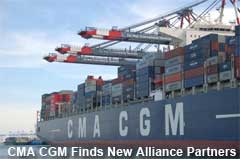From SCDigest's On-Target e-Magazine
- Sept. 10, 2014 -
Global Supply Chain News: Jilted CMA CGM Finds New Partners with Ocean Three Alliance, as Carrier Differentiation about Gone, Maersk Line CEO Says
Proposed Ocean Three Allliance to be "Antidote" to 2M from Maersk and MSC; Container Carriers Now Like Airlines, Maersk CEO Skou Says
SCDigest Editorial Staff
French container carrier CMA CGM, which saw its proposed partners in the P3 Network consortium Maersk Line and Mediterranean Shipping Co. instead announced a two-carrier 2M alliance in July after China regulators rejected the P3 concept, found itself some new partners this week.
CMA CGM said it is partnering with China Shipping Container Lines Co. and United Arab Shipping Co. to form the new Ocean Three alliance. The consortium is expected to deploy some 150 ships that would move roughly 20% of all cargo between Asia and Europe and 13% and 7% across the Pacific and Atlantic oceans.
SCDigest Says: |
 |
With no differentiation on the physical service, and minor at best differentiation on other aspects of customer service, what's left for the carriers?
|
|
What Do You Say?
|
|
|
|
The French carrier, the industry's third largest, said the combined effort would call "in all the biggest Asian, European and North American ports, using transshipment hubs common to the three partners."
The agreement includes a combination of vessel-sharing agreements, slot exchange deals and slot charter arrangements. In general, these alliances involve the carrier members marketing, pricing and selling their container services independently, but once sold the boxes will move on the ships of any of the carrier members. This provides both operational efficiency and should boost volumes on any particular sailing, meaning more capacity of the giant, lower cost per unit megaships can be utilized through the combined volumes.
That is an important consideration for the Ocean Three members. UASC has six 18,800-TEU ships on order and China Shipping is awaiting delivery of five 19,000-TEU units, which will be the largest container vessels in operation. CMA CGM has six 17,700 to 17,800-TEU units on order, scheduled for delivery in 2015. The great unit cost advantages of these giant ships dissipates quickly if they are not full or nearly full.
The Ocean Three agreement would be valid for two years after the start of operations and would be automatically extended if and until one of the carriers wants out.
Maersk and MSC obviously hope that by cutting the scale of what was P3 down by roughly a third with the removal of CMA CGM from the mix that Chinese regulators will give the partnership the OK. Before the Chinese decision, American and European Union authorities had already given approval to the full P3 plans.
 The announcement of 2M obviously left CMA CGM standing at the alter looking for a partner, and it found two in China Shipping and UASC. The announcement of 2M obviously left CMA CGM standing at the alter looking for a partner, and it found two in China Shipping and UASC.
Ocean Three will operate four weekly trans-Pacific services to California ports and one service to the Pacific Northwest. It will run one service via the Suez Canal on the Asia-U.S. East Coast trade and a separate service dedicated to the Gulf of Mexico.
"Ocean Three is an antidote to 2M," Jonathan Roach, a container analyst with London-based Braemar ACM Shipbroking, told the Wall Street Journal. "It's in line with staying competitive with the 2M and it's a good deal, because they have invested in some of the biggest ships in the business and also brought a Chinese company into the fold."
(Global Supply Chain Article Continued Below)
|